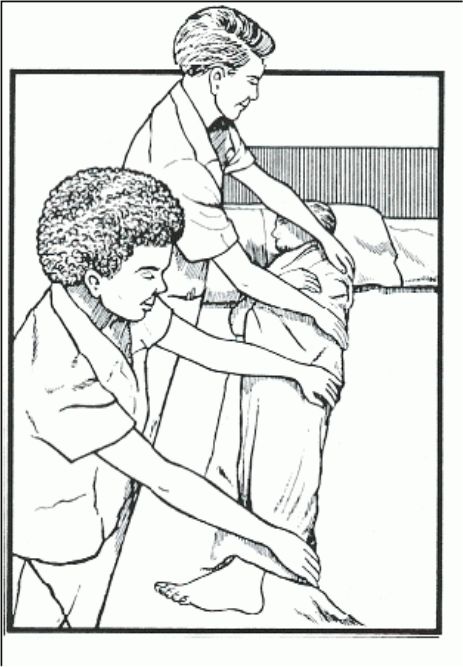a. General Principles for Turning the Adult Patient.
Sometimes the physician will specify how often to turn a patient. A schedule can be set up for turning the adult patient throughout his “awake” hours.
The patient should be rotated through four positions (unless a particular position is contraindicated):
- Prone (see figure 4-1 and section 4-13).
- Supine (figure 4-2 and section 4-13).
- Left Sim’s (figure 4-3).
- Right Sim’s (figure 4-3).
Plan a schedule and follow it. Record the position change each time to ensure that all positions are used.



One example of a schedule for turning would be:
- 1000– Prone position
- 1200–Left Sim’s position
- 1400–Supine position
- 1600–Right Sim’s position
- 1800–Prone position
Notice that in the preceding sequence, the patient is required to make only a quarter turn rather than a half turn each time the position is changed. If the patient experiences pain while turning, a quarter turn will be less painful than a half turn.
Certain conditions may make it impossible to turn the patient. Turning may be impossible if the patient has fractures that require traction appliances. Turning may be harmful to patients with spinal injuries. In these cases, you need to rub the back by lifting the patient slightly off the bed and massaging with your hand held flat. It is especially important to prevent skin breakdowns in the person who lies on his back for long periods of time.
NOTE: For the initial development of skin breakdown, a patient does not have to lie on his back for long periods of time, especially if moisture and sheet wrinkles are present.
You may want to turn a patient only to wash or rub the back or change the bed.

Logrolling (see figure 4-4).
Description.
Logrolling is a technique used to turn a patient whose body must at all times be kept in a straight alignment (like a log).
This technique is used for the patient who has a spinal injury.
Logrolling is used for the patient who must be turned in one movement, without twisting.
Logrolling requires two people, or if the patient is large, three people.
Technique.
Wash your hands.
Approach and identify the patient (by checking the identification band) and explain the procedure (using simple terms and pointing out the benefits).
Provide privacy.
Position the bed.
The bed should be in the flat position at a comfortable working height.
Lower the side rail on the side of the body at which you are working.
Position yourself with your feet apart and your knees flexed close to the side of the bed.
Fold the patient’s arms across his chest.
Place your arms under the patient so that a major portion of the patient’s weight is centered between your arms. The arm of one nurse should support the patient’s head and neck.
On the count of three, move the patient to the side of the bed, rocking backward on your heels and keeping the patient’s body in correct alignment.
Raise the side rail on that side of the bed.
Move to the other side of the bed.
Place a pillow under the patient’s head and another between his legs.
Position the patient’s near arm toward you.
Grasp the far side of the patient’s body with your hands evenly distributed from the shoulder to the thigh.
On the count of three, roll the patient to a lateral position, rocking backward onto your heels.
Place pillows in front of and behind the patient’s trunk to support his alignment in the lateral position.
Provide for the patient’s comfort and safety.
1 Position the call bell.
2 Place personal items within reach.
3 Be sure the side rails are up and secure.
Report and record as appropriate.
